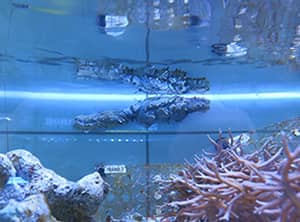28.1.16 | At the ZMT’s marine experimental facility (MAREE) a very rare and fascinating event took place recently when one of the institute’s sea cucumbers of the species Stichopus vastus (Curryfish) reproduced through fission.
Fission is the asexual form of reproduction in sea cucumbers. It is only very occasionally witnessed inside an aquarium, says Dr. Andreas Kunzmann, biologist and head of the work group “Ecophysiology” at the ZMT.
In the wild fission occurs regularly, but only 16 of 1,200 species are known to reproduce asexually. To exhibit this behaviour in artificial surroundings sea cucumbers require optimal environmental conditions – salinity, temperature, oxygen, pH value and alkalinity of the sea water tank need to be precisely tailored to the needs of the marine animals.
“A sea cucumber only reproduces through fission if it is very comfortable in its habitat”, explains Dr. Kunzmann, an expert in aquaristics and aquaculture at the ZMT.
The sea cucumber from Indoensia affectionately called “Gurki” by ZMT staff, has been living at the institute’s marine experimental facility since November 2014. During this time it has already twice undergone fission.
“Sea cucumbers are calcifying organisms and have an endoskeleton consisting of calcium carbonate,” says Dr. Kunzmann. “Hence the balance of ions in the water of the tank has to be just right for calcification to take place – this also is related to solubility products and alkalinity. All of these parameters have to be in equilibrium. Functioning calcification is the prerequisite for the sea cucumber to even start the fission process.”
Scientists at the ZMT mainly investigate the metabolism of sea cucumbers in order to draw conclusions about the animal’s energy and feed requirements. They examine how sea cucumbers adapt to global changes such as temperature fluctuations or ocean acidification. In addition the researchers also work on the production of potential bioactive substances.
In China, sea cucumbers are regarded as a delicacy and sold under the brand names “Trepang” oder “Beche-de-mer”. Gobal trade with sea cucumbers has increased significantly in recent years. In the Indo-Pacific region the animals are overfished to such an extend that some of the more than 1,200 known species are now under threat.
“Currently only a few species are grown in so-called hatcheries employing the method of sexual reproduction,” says Dr. Kunzmann. “Hence each new research result contributes our understanding of the biology and the function of sea cucumbers within the ecosystem, which further down the line might allow us to cultivate new species in aquaculture and thus reducing the pressure on the global fishing trade. Education, information and aquaculture can therefore help to protect the wild species.”





